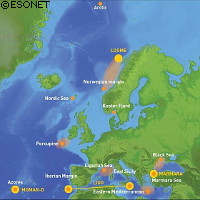Polarstern installs Arctic Ocean observatory
EU-funded researchers have succeeded in installing a new deep-sea observatory to monitor a mud volcano in the Arctic region. The observation ward was established during the research vessel Polarstern's 24th Arctic expedition from mid-July to early August. The study is part of the ESONET ('European seas observatory network') project, funded under the EU's Sixth Framework Programme (FP6) with EUR 7 million. The observatory will provide information about the dynamics of future gas eruptions, and demonstrate how these eruptions will impact the deep waters of the Norwegian Sea. Included in the observatory are 16 separate stations at depths of up to 5,500 metres. The researchers, led by scientists based in Bremen, Germany, can determine changes following 10 years worth of research in a deep ecosystem in the Arctic Ocean. 'The distribution of the long-term observatory is an important milestone of the project ESONET,' said Dr Dirk De Beer, project coordinator from the Max Planck Institute for Marine Microbiology in Germany. 'It was possible to install the complicated construction of the observatory as planned with the help of all partners from Germany, France and Norway involved in the project. It shows again that good collaboration of the involved institutes is an important component of European marine research.' A total of 50 researchers from 7 countries took part in the research on board the Polarstern, an icebreaker belonging to the Alfred Wegener Institute (AWI). The researchers explained that they will also evaluate another area located west of Spitsbergen, a Norwegian island and the largest island of the Svalbard archipelago in the Arctic Ocean. This observation area, called 'Hausgarten', belongs to the AWI for Polar and Marine Research in the Helmholtz Association of German Research Centres. The Hausgarten represents a key site of the ESONET project. According to the research team, the Fram Strait between eastern Greenland and Spitsbergen is the only deep-sea connection between the central Arctic Ocean and the North Atlantic. The scientists said they found that the water temperature has increased by a tenth of a degree Celsius at a depth of 2,500 metres. They also discovered that oxygen saturation had shrunk at the boundary layer between the seafloor and water, and that the composition of the animal community had changed much more quickly than anticipated. 'Whether we really observe consequences of rapid change in the Arctic in several thousand metres of water depth, or if we are witnesses to natural changes taking place over several decades will be seen after the analysis of our data and further research,' explained Dr Michael Klages, a researcher at AWI and chief scientist of the expedition. Apart from the installation of the observatory in the Norwegian Sea, the scientists also set out to build the long-term observatory LOOME ('Long-term observation of mud volcano eruptions') during the trip. The objective of LOOME is to fuel understanding about the Haakon Mosby mud volcano that is located in the south-western Barents Sea, in particular about what is happening within the volcano. According to the team, the Haakon Mosby mud volcano is 1,250 metres deep in the sea and has a diameter of about 1.5 kilometres (km). Mud, gases and water are pressed from the centre of the active mud volcano from a depth of around three km to the surface of the seafloor. The efflux decreases in the direction of the outer areas of this structure, they said. Methane gas hydrates are found in this spot, effectively helping stabilise the area.
Countries
Germany, France, Norway



